铅扣:lead button
lead button为火试金名词,词义为铅扣。
通过高温坩埚熔样获得的铅扣,然后通过将贵金属从铅中分离出来的过程称为“灰吹”。一般灰吹灰皿采用镁砂灰皿。
铅迅速氧化为熔融的氧化铅O,其中98.5%被灰皿吸收,1.5%被挥发掉。当该灰吹过程完成后,贵金属以珠子的形式留在灰皿上。灰皿内壁其本身可被视为一种可渗透熔融锂的膜(PbO),对铅和贵金属不渗透。
灰皿法CUPELLATION
通过高温坩埚熔样获得的铅扣,然后通过将贵金属从铅中分离出来的过程称为“灰吹”。
一般灰吹灰皿采用镁砂灰皿。
铅迅速氧化为熔融的PbO,其中98.5%被灰皿吸收,1.5%被挥发掉。当该灰吹过程完成后,贵金属以珠子的形式留在灰皿上。灰皿内壁其本身可被视为一种可渗透熔融锂的膜(PbO),对铅和贵金属不渗透。
先,根据铅扣。对于重量小于等于32 g的铅扣,1.5英寸-直径使用(直径3.8厘米)的灰皿,重量为32-48克,1.75英寸的铅扣-使用直径(4.4-cm-diameter)的灰皿。由于熔炉的高热和便于搬运,因此一次应将18-24个以上的铅扣做成灰皿状。用铅笔,给样品编号。
然后,将它们按数字顺序排列在碗形加料盘上,每六行与铅扣盘上编号相同的铅扣所处的位置相对应。当1.5英寸时,样品灰皿仍在托盘上。在里面直径,由一排屏蔽灰皿()包围前排(熔炉后部)和侧面尺寸相同的灰皿。较大尺寸(1.75英寸)空灰皿用作背部的护罩row(距离炉门设计近)。当所有样本灰皿均为1.75英寸时。在直径上,所有周围的屏蔽罩都是这种尺寸。这个屏蔽灰皿用于保护样品灰皿不受气流影响,从而减少“冻结”Qead氧化物覆盖熔融铅和防止进一步氧化)。
然后通过和放置在距离后部。用灰皿钳,以便所有灰皿相互接触。
关闭炉门,温度设置为800℃。当达到温度时,应穿戴实验室外套和石棉手套磨损,打开炉门。随后,炉门关闭,温度为升高至1000℃。当达到该温度时,铅扣托盘带铅扣放置在炉门架上。所有隔热设备均已磨损,铅扣已转移到样品上使用铅扣夹钳的橱柜。
(门是关闭几分钟,然后打开以查看铅扣是否“打开”Qead铅扣全部熔化并呈红色)。当铅扣“打开”时,炉门保持打开当铅扣“打开”时,炉门保持打开,并且温度降至840℃。灰吹时,应尽快降低温度,以避免贵金属损失到灰皿璧。可以使用带排气排气扇的灰吹炉,以补充自然通风。如果灰吹炉还配备了罩式排气罩,这也应打开,防止尾气损伤操作人员健康。
灰吹实验应在具有良好通风环境室内进行。
当温度达到840℃时,关闭所有进气,关闭炉门。通过观察窗可观察到灰吹。如果混合了小灰皿和大灰皿,则应调整小灰皿和大灰皿的温度设置。温度保持在840℃ ,5-10分钟熔融铅质量呈穹顶状外观后。那就是了升高至860℃并在此温度下再保持5-10分钟在此之后,将其升高至880℃并保持相同的时间时间在此时间之后,或当铅扣的大小减小到no时小于0.19-0.25英寸。(0.5 cm),温度升至900℃保持在这个温度直到所有的铅都消失珠子仍然存在。有时可能需要将温度提高到910℃-920℃,尤其是在室外寒冷和低海拔地区。当看到氧化铅时,就可以确定这一点烟雾从车门的开口处进入。如果出现这种情况,请打开上部排气风扇,通过烟囱。获得所有珠子后,关闭灰吹炉,然后用装料叉取出。然后是后排
(设计靠近炉门)和侧排屏蔽柜取下,一次两个,用灰皿钳放在钢制砸样工作台。随后,带有珠子的样品灰皿为砸出,然后在同样的方法,放在的工作台旁边。样品灰皿冷却称量珠子。
用炉耙、炉铲把炉底板清洁干净平了。
本程序中的温度用于测定以金为捕收剂的铂金属。然而,对于金的测定,使用银作为捕收剂,灰吹是除温度次降至820℃和880℃下完成
灰皿法CUPELLATION
he lead button obtained from the crucible fusion is treated by a process called cupellation to separate the noble metals from the lead. This consists of an oxidizing fusion in a porous vessel made of compressed bone ash called a cupel. The lead oxidizes rapidly to molten PbO, 98.5 percent of which is absorbed by the cupel and 1.5 percent of which is volatilized. When this process has been carried to completion, the noble metals are left on the cupel in the form of a bead. The cupel itself may be regarded as a membrane permeable to molten litharge (PbO) and impermeable to lead and the noble metals. First, the size of the cupel is selected on the basis of the weight of the lead button. For buttons weighing 32 g or less, 1.5-in.-diameter (3.8-cm-diameter) cupels are used, and for buttons weighing 32 -48 g,
1.75-in.-diameter (4.4-cm-diameter) cupels are used. Due to the intense heat of the furnace and for convenience of handling, no more than 18-24 buttons should be cupelled at a time. The cupels are numbered with a diamond-tip pencil, using the last three digits of the sample number. They are then arranged in numerical order in rows of six on the cupel-charging tray (fig. 4) to correspond to the position taken by the same-numbered button on the button tray. While still on the tray the sample cupels, when 1.5 in. in diameter, are surrounded by a single row of shielding cupels (blank cupels) of the same size for the front row (rear of furnace) and sides. The larger size (1.75 in.) blank cupels are used as shields for the back row (nearest the furnace door). When all the sample cupels are 1.75 in. in diameter, all the surrounding shielding cupels are of that size. The shielding cupels are used to protect the sample cupels from drafts, thus reducing the dangers of "freezing" Qead oxide covering the molten lead and preventing further oxidation). The cupels are then transferred to the cold furnace by means of the cupel charging tray and are placed about two-thirds the distance to the rear. The outermost cupel of each row is tapped lightly with the cupel tongs (fig. 9) so that all cupels are touching one another. The furnace door is closed, and the temperature is set for 800°C. When this temperature is attained, a laboratory coat and asbestos gloves are worn, the furnace door is opened, and two rows of shielding scorifiers (scorifiers loaded with graphite electrodes) are placed in front of the cupels lining the charging fork. The scorifiers with graphite aid in reducing the otherwise highly oxidizing atmosphere so that oxidation will proceed at a desirable rate. They also aid by heating the air which passes over them, preventing "freezing" of the buttons. Following this, the furnace door is closed, and the temperature is raised to 1000°C. When this temperature is attained, the button tray with buttons is placed on the furnace-door shelf. All the heat protection equipment is worn, and the buttons are transferred to the sample cupels using the button tongs (fig. 9). (See figs. 16, 17.) The door is closed for a few minutes then opened to see that the buttons are "open" Qead buttons become molten and red throughout). When the buttons are "open," the furnace door is kept open and the temperature is decreased to 840°C. It is desirable to decrease the temperature as rapidly as possible to avoid losses of the noble metals to the cupels. This can be accomplished readily by using the exhaust fan built into all modern furnaces to supplement natural draft. If the furnace is also equipped with a canopy-type exhaust hood, this also should be turned on. An air conditioner, in addition to both fans, is advantageous particularly in the summertime. All measures available to a laboratory to produce better ventilation in the room should be employed during this step of the cupellation.
When the temperature has reached 840°C, all fans are turned off, and the furnace door is raised to about 1.5 in. (3.8 cm) of the top so that one can observe the cupellation. If there is a mixture of small and CUPELLATION 37 large cupels, the temperature settings should be adjusted for the small cupels. The temperature is maintained at 840°C for 5-10 minutes after the molten lead mass assumes a domelike appearance. Then it is raised to 860°C and held at this temperature for another 5-10 minutes. After this it is raised to 880°C and held for the same period of time. After this time, or when the buttons have decreased in size to no less than 0.19-0.25 in. (0.5 cm), the temperature is raised to 900°C and maintained at this temperature until all the lead is gone and only the beads remain. At times it may be necessary to increase the finishing temperature to 910° -920°C, especially when it is cold outdoors and a down draft exists. One can determine this when he sees lead-oxide fumes coming through the opening set for the door. If this should occur, turn on the upper exhaust fan(s) to exhaust the fumes through the chimney. After all the beads are obtained the furnace is turned off, and the scorifiers are removed with the charging fork. Then the back row (closest to the furnace door) and side rows of shielding cupels are removed, two at a time, with the cupel tongs (fig. 9) and placed on the steel table. Following this, the sample cupels with beads (fig. 18) are removed, and then the front row of shielding cupels is removed in the same way and placed beside the blank cupels. The furnace is raked smooth with bone ash, and the sample cupels are allowed to cool before weighing the beads (fig. 19). The temperatures in this procedure are for the determination of platinum metals using gold as a collector. However, for the determination of gold, using silver as a collector, the cupellation procedure is the same except that the temperature is first lowered to 820°C and finished at 880°C.
When the sample contains major amounts of copper (more than 10 percent), caution should be exercised in cupelling the button. In one instance, the button "froze" during cupellation, and it was necessary to scorify the button obtained after a second fusion. Scorification helped to reduce the amount of copper in the button, resulting in a successful cupellation. However, in other instances where copper was in major amounts, as indicated by a semiquantitative spectrographic analysis, scorification was not necessary. This may be due to the relative amounts of copper in each sample. Other metals which alloy with lead may present similar problems and may require the same treatment


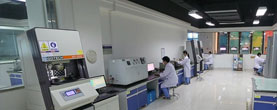
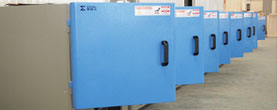
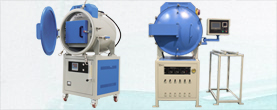
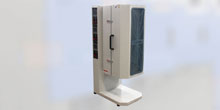
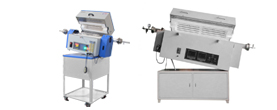

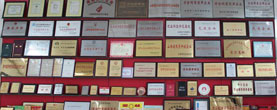
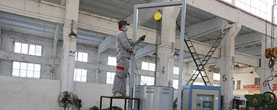







 售前客服
售前客服